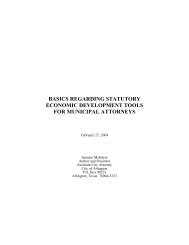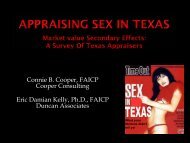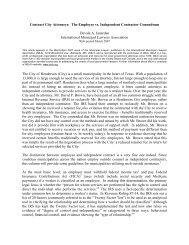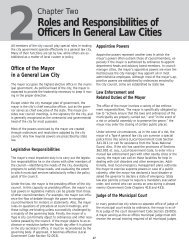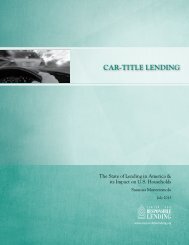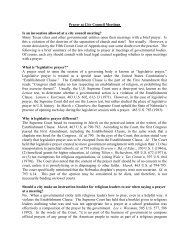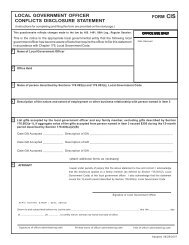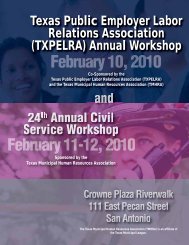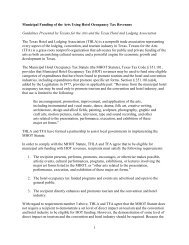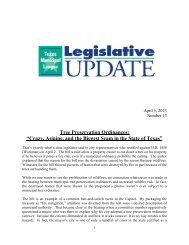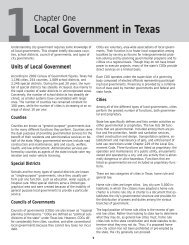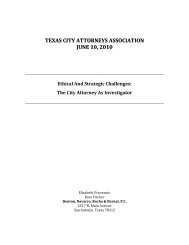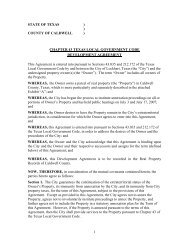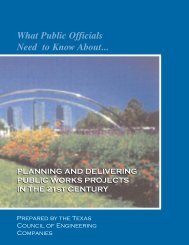Outdoor Burning in Texas - Texas Municipal League
Outdoor Burning in Texas - Texas Municipal League
Outdoor Burning in Texas - Texas Municipal League
- No tags were found...
You also want an ePaper? Increase the reach of your titles
YUMPU automatically turns print PDFs into web optimized ePapers that Google loves.
OUTDOOR BURNING IN TEXASburn<strong>in</strong>g—for example, which way (and how fast) the w<strong>in</strong>dis blow<strong>in</strong>g, whether w<strong>in</strong>ds are expected to shift, whetheryour area is under a temperature <strong>in</strong>version, and whetherhigh ozone levels are forecast.How do I report somebody who isconduct<strong>in</strong>g illegal outdoor burn<strong>in</strong>g?Report the burn<strong>in</strong>g to the local air pollution control office,or the nearest TCEQ regional office. The TCEQ’s EnvironmentalCompla<strong>in</strong>t Hotl<strong>in</strong>e is 888-777-3186. Compla<strong>in</strong>tscan also be submitted by e-mail at or on the agency web site us<strong>in</strong>g the onl<strong>in</strong>e form.Exceptions to the ProhibitionThe standard exceptions, expla<strong>in</strong>ed below, cover themost common situations <strong>in</strong> which burn<strong>in</strong>g is an acceptablepractice. In most of these <strong>in</strong>stances, the burn<strong>in</strong>gmust follow the general requirements outl<strong>in</strong>ed later <strong>in</strong> thisdocument. It may be necessary to notify the TCEQ, localgovernmental agencies, and neighbors before conduct<strong>in</strong>gburn<strong>in</strong>g under one of these exceptions. See Appendix A fordetails on notification requirements <strong>in</strong> specific situations.There may be local ord<strong>in</strong>ances or county burn bans thatregulate burn<strong>in</strong>g; if so, the requirements and restrictions ofthose ord<strong>in</strong>ances must also be met.Firefighter Tra<strong>in</strong><strong>in</strong>gOrganizations that tra<strong>in</strong> firefighters may obta<strong>in</strong> authorizationto conduct outdoor burn<strong>in</strong>g for such tra<strong>in</strong><strong>in</strong>g,<strong>in</strong>clud<strong>in</strong>g tra<strong>in</strong><strong>in</strong>g <strong>in</strong> the operation of fire ext<strong>in</strong>guishers. Toobta<strong>in</strong> an authorization, the organization responsible for thetra<strong>in</strong><strong>in</strong>g must send a written request to the local air pollutioncontrol agency under contract with the TCEQ or, if there isno such agency, the appropriate TCEQ regional office. For alist of regional offices, see Appendix B.If tra<strong>in</strong><strong>in</strong>g occurs regularly at a dedicated facility, it maybe possible to <strong>in</strong>form the regional office of all such tra<strong>in</strong><strong>in</strong>gevents with one annual written notification. If a dedicatedtra<strong>in</strong><strong>in</strong>g facility conducts tra<strong>in</strong><strong>in</strong>g regularly but less oftenthan once a week, a telephone or fax notification will benecessary 24 hours <strong>in</strong> advance of each event.<strong>Burn<strong>in</strong>g</strong> conducted to tra<strong>in</strong> firefighters does not have toconform to the general requirements for other forms of allowableoutdoor burn<strong>in</strong>g, but it must not cause a nuisance ortraffic hazard. The TCEQ may revoke its authorization if itis used <strong>in</strong> an attempt to avoid comply<strong>in</strong>g with other portionsof the <strong>Outdoor</strong> <strong>Burn<strong>in</strong>g</strong> Rule.We want to conduct fire tra<strong>in</strong><strong>in</strong>g forour volunteer fire department.Can we burn this abandoned house?The tra<strong>in</strong><strong>in</strong>g of firefighters may be authorized as anexception to the prohibition on outdoor burn<strong>in</strong>g. Submit awritten request on behalf of the VFD to the local air pollutioncontrol agency, or, if there is no local agency, theTCEQ office for your region. The TCEQ may authorize suchtra<strong>in</strong><strong>in</strong>g orally or <strong>in</strong> writ<strong>in</strong>g; if it denies the request, yourVFD will receive a notice of denial with<strong>in</strong> 10 work<strong>in</strong>g daysafter the postmark date or the date of personal delivery ofthe request to the regional office. To ensure that the fire willnot form or disperse toxic substances, the local air pollutioncontrol agency or the review<strong>in</strong>g TCEQ regional office mayrequire that the build<strong>in</strong>g be stripped of many common constructionmaterials—<strong>in</strong>clud<strong>in</strong>g electrical wir<strong>in</strong>g, lead flash<strong>in</strong>g,carpet, asbestos, and many others—before the fire is ignited.Note that the burn<strong>in</strong>g of abandoned build<strong>in</strong>gs by a firedepartment is not automatically considered fire tra<strong>in</strong><strong>in</strong>g.There must be a specific benefit to the fire department. Simplyprevent<strong>in</strong>g the spread of fire from an abandoned build<strong>in</strong>gto neighbor<strong>in</strong>g property is not considered tra<strong>in</strong><strong>in</strong>g. Suchburns constitute an attempt to circumvent the prohibitions<strong>in</strong> the <strong>Outdoor</strong> <strong>Burn<strong>in</strong>g</strong> Rule and are prohibited.Fires for Recreation, Ceremonies,Cook<strong>in</strong>g, or Warmth<strong>Outdoor</strong> burn<strong>in</strong>g is allowed when used solely forrecreational or ceremonial purposes, <strong>in</strong> the noncommercialpreparation of food, or exclusively as a means of generat<strong>in</strong>gwarmth <strong>in</strong> cold weather. In other words, campfires, bonfires,and cook<strong>in</strong>g fires are allowed. Fires built under this exceptionmay not conta<strong>in</strong> electrical <strong>in</strong>sulation, treated lumber, plastics,construction or demolition materials not made of wood,heavy oils, asphaltic materials, potentially explosive materials,chemical wastes, or items conta<strong>in</strong><strong>in</strong>g natural or syntheticrubber. The other general requirements on allowable outdoorburn<strong>in</strong>g do not apply to fires covered by this exception, butthe burn<strong>in</strong>g must not cause a nuisance or traffic hazard.May I cook food on my charcoalgrill <strong>in</strong> my backyard?Yes. Fires used <strong>in</strong> the noncommercial preparation of foodare allowed.May I build a fire <strong>in</strong> my fireplace?Yes. Indoor fires are not regulated by the <strong>Outdoor</strong> <strong>Burn<strong>in</strong>g</strong>Rule. Domestic-use fireplaces are authorized under theTCEQ’s de m<strong>in</strong>imis rules <strong>in</strong> 30 TAC 116.119.4 TEXAS COMMISSION ON ENVIRONMENTAL QUALITY
OUTDOOR BURNING IN TEXASAre campfires allowed <strong>in</strong>side the city limits?Sometimes. Fires used solely for recreation or ceremonyare allowed by state law; however, local ord<strong>in</strong>ance mayprohibit this k<strong>in</strong>d of burn<strong>in</strong>g. Make sure no oils, asphalt,synthetic rubber, or other materials that produce heavysmoke are <strong>in</strong> the fire: they could release toxic gases or cause anuisance or traffic hazard.Fires for Disposal or Land Clear<strong>in</strong>gA broad exception for fires to dispose of waste or clearland covers seven more specific categories, described below.Residents of Montgomery County are subject to special restrictions(see below); these restrictions could be extended toother areas of the state should growth <strong>in</strong> neighbor<strong>in</strong>g countiesrender them subject to the provisions of Local GovernmentCode 352.082.1. Domestic waste. Domestic waste—<strong>in</strong> other words,household trash or rubbish—may be burned when the localgovernmental organization with jurisdiction over such mattersdoes not collect trash and does not authorize a bus<strong>in</strong>essor other service to do so. To qualify for this exception, thewaste must come from a property that is (1) designed tobe a private residence and (2) used exclusively as a privateresidence for no more than three families. The waste mustalso be burned on the property where it was produced. Accord<strong>in</strong>gto TCEQ rules [30 TAC 101.1(26)], domestic wastes<strong>in</strong>clude wastes that normally result from the function of lifewith<strong>in</strong> a residence—for example, kitchen garbage, untreatedlumber, cardboard boxes, packag<strong>in</strong>g, cloth<strong>in</strong>g, grass, leaves,and branch trimm<strong>in</strong>gs. Such th<strong>in</strong>gs as tires, constructiondebris, furniture, carpet, electrical wire, and appliances arenot considered to be domestic waste and cannot be burned.Other conditions of the general requirements for outdoorburn<strong>in</strong>g do not apply to the burn<strong>in</strong>g of domestic waste, butthe outdoor burn must not cause a nuisance or traffic hazard.2. Diseased animal carcasses. These may be burnedwhen burn<strong>in</strong>g is the most effective means of controll<strong>in</strong>gthe spread of disease. The general requirements for outdoorburn<strong>in</strong>g do not apply to this exception, but burn<strong>in</strong>g underthis exception must not cause a nuisance or traffic hazard.3. <strong>Burn<strong>in</strong>g</strong> of animal rema<strong>in</strong>s by a veter<strong>in</strong>arian. A veter<strong>in</strong>arianmay burn animal rema<strong>in</strong>s and medical waste—not<strong>in</strong>clud<strong>in</strong>g sharps (e.g., needles)—associated with animals <strong>in</strong>his or her care on his or her property if the property is locatedoutside the corporate boundaries of a municipality (orwith<strong>in</strong> the corporate boundaries of a municipality if annexedon or after September 1, 2003). This section prevails overany other law that authorizes a governmental entity to abatea public nuisance. (Occupations Code 801.361.)4. On-site burn<strong>in</strong>g of waste plant growth. Trees, brush,grass, leaves, branch trimm<strong>in</strong>gs, or other plant growth maybe burned on the property on which the material grew. Theplant growth must be burned by the property owner or anyother person authorized by the owner. Additional requirementsand restrictions apply depend<strong>in</strong>g on the atta<strong>in</strong>mentstatus of the county where the burn<strong>in</strong>g takes place.All designated nonatta<strong>in</strong>ment counties and someatta<strong>in</strong>ment counties. <strong>Burn<strong>in</strong>g</strong> of waste plant growth isallowed only if the material was generated as a result ofright-of-way ma<strong>in</strong>tenance, land clear<strong>in</strong>g, or ma<strong>in</strong>tenancealong water canals. <strong>Burn<strong>in</strong>g</strong> <strong>in</strong> these areas is allowedonly when no practical alternative exists. <strong>Burn<strong>in</strong>g</strong> carriedout under this exception must conform to all the generalrequirements for outdoor burn<strong>in</strong>g.Most atta<strong>in</strong>ment counties. <strong>Burn<strong>in</strong>g</strong> of waste plantgrowth is allowed regardless of the activity that generatedthe material. Practical alternatives need not beconsidered. <strong>Burn<strong>in</strong>g</strong> carried out under this exceptionmust conform to some of the general requirements foroutdoor burn<strong>in</strong>g, specifically the burn<strong>in</strong>g must conformto the requirements <strong>in</strong> 30 TAC 111.219(3, 4, 6, 7)(see Appendix C). Such burn<strong>in</strong>g is also subject to localord<strong>in</strong>ances which prohibit burn<strong>in</strong>g <strong>in</strong> the corporatelimits of a city or town. Some atta<strong>in</strong>ment counties aretreated as nonatta<strong>in</strong>ment counties for the purposes ofthis exception. Specifically, any atta<strong>in</strong>ment county thatconta<strong>in</strong>s any part of a municipality that extends <strong>in</strong>to aborder<strong>in</strong>g nonatta<strong>in</strong>ment county is treated as a nonatta<strong>in</strong>mentcounty for the purposes of this exception.To determ<strong>in</strong>e if your county is an atta<strong>in</strong>ment or a nonatta<strong>in</strong>mentcounty for the purposes of this exception, call yourregional TCEQ office. TCEQ regional office phone numbersappear <strong>in</strong> Appendix B.5. Designated burn sites. This exception allows ruralhomeowners to transport their yard waste to a designatedsite for consolidated burn<strong>in</strong>g, rather than hav<strong>in</strong>g numeroussmaller fires <strong>in</strong> the yards of rural neighborhoods. All burn<strong>in</strong>gat a designated site must be directly supervised by a firedepartmentemployee. Designated burn sites must be locatedoutside the corporate limits of a municipality and with<strong>in</strong>a county that has a population of less than 50,000. Thesite must be designated by its owner; designation does notrequire registration with the agency. A site is designated by:• post<strong>in</strong>g all entrances to the site with a placard measur<strong>in</strong>gat least 2 feet wide by 4 feet high bear<strong>in</strong>g specific<strong>in</strong>formation as provided <strong>in</strong> 30 TAC 111.209(5)(A) (seeAppendix C)—each placard must be clearly visible andlegible at all times; andTEXAS COMMISSION ON ENVIRONMENTAL QUALITY 5
OUTDOOR BURNING IN TEXAS• specify<strong>in</strong>g residential properties for which the site hasbeen designated, and ma<strong>in</strong>ta<strong>in</strong><strong>in</strong>g a record of thosespecific residential properties. The record must conta<strong>in</strong>a description of a platted subdivision, a list of all specificresidential addresses, or both. This record must be madeavailable with<strong>in</strong> 48 hours of any request by any authorityhav<strong>in</strong>g jurisdiction.Furthermore, the owner of the site is required to ensurethat all activities at the site comply with this exception. Theowner must:• ensure that all waste burned at the site consists of trees,brush, grass, leaves, branch trimm<strong>in</strong>gs, or other plantgrowth, and was generated at one of the specific residentialproperties for which the site is designated; and• ensure that all burn<strong>in</strong>g at the site is directly supervisedby a paid, on-duty fire department employee who ispart of the fire protection personnel and is act<strong>in</strong>g <strong>in</strong> thescope of his or her employment. The fire-departmentemployee must notify the appropriate TCEQ regionaloffice by phone or fax 24 hours <strong>in</strong> advance of each burn.The TCEQ will supply the employee with <strong>in</strong>formationon practical alternatives to burn<strong>in</strong>g.6. Crop residues. When there is no practical alternative,crop residues may be burned as part of agriculturalmanagement. <strong>Burn<strong>in</strong>g</strong> carried out under this exception mustconform to the general requirements for outdoor burn<strong>in</strong>g,and structures conta<strong>in</strong><strong>in</strong>g “sensitive receptors” (see box) mustnot be negatively affected by the burn. This exception doesnot apply to crop-residue burn<strong>in</strong>g covered by an adm<strong>in</strong>istrativeorder.“Sensitive receptors” <strong>in</strong>clude humans and livestock,as well as “sensitive live vegetation” suchas nursery plants, mushrooms under cultivation,and plants raised for pharmaceutical production orused <strong>in</strong> lab experiments. For a complete def<strong>in</strong>ition,see 30 TAC 111.203(7).7. Brush, trees, etc., off-site. A county or municipalgovernment may request site and burn approval from theappropriate TCEQ regional office to burn accumulationsof brush, trees, and other plant growth that cause a conditiondetrimental to public health and safety. The burn mustoccur at a site owned by the local government and will beauthorized only if the TCEQ determ<strong>in</strong>es that there is nopractical alternative. The frequency of such burns may notexceed once every two months, and they cannot be used <strong>in</strong>place of other sound brush-management practices. <strong>Burn<strong>in</strong>g</strong>conducted under this exception must conform to the generalrequirements for allowable outdoor burn<strong>in</strong>g. The burn<strong>in</strong>gmay not occur at a municipal landfill without advance permissionfrom the TCEQ.Special restrictions <strong>in</strong> Montgomery County. Regardlessof the seven exceptions given above, <strong>in</strong> un<strong>in</strong>corporated areasof Montgomery County it is a crim<strong>in</strong>al offense, as well as aviolation of agency rules, to burn household refuse on a lotsmaller than five acres or located <strong>in</strong> a “neighborhood.” Theterms “neighborhood” and “refuse” are def<strong>in</strong>ed <strong>in</strong> 30 TAC111.203 (see Appendix C). Under Local Government Code352.082, this restriction could <strong>in</strong> the future also apply tocerta<strong>in</strong> planned communities if a county adjacent to the onewhere such a community is located grows to 3.3 million ormore <strong>in</strong> population.I live <strong>in</strong> a small rural town where most peoplehave their trash picked up by a commercialtrash collection service. I can’t afford to paythat money each month. May I burn my trash<strong>in</strong> a 55-gallon drum <strong>in</strong> my backyard?If the local city ord<strong>in</strong>ance does not make it mandatorythat trash be picked up, and there is no governmentallyauthorized trash-collection service available to you, you mayburn domestic waste on the property where it is produced,as long as outdoor burn<strong>in</strong>g is not prohibited by local rule orord<strong>in</strong>ance and does not create a nuisance or a traffic hazard.May I burn my old oil filters <strong>in</strong> ametal barrel on my property?No. Take oil filters to an authorized recycl<strong>in</strong>g site, alongwith your used oil. You may call 800-CLEAN-UP for more<strong>in</strong>formation on recycl<strong>in</strong>g.I want to burn boxes from my bus<strong>in</strong>ess.The TCEQ rules say that I may burn wastefrom my residence, but what about wastefrom my bus<strong>in</strong>ess?Accord<strong>in</strong>g to the <strong>Outdoor</strong> <strong>Burn<strong>in</strong>g</strong> Rule, you can’tburn bus<strong>in</strong>ess waste. The exception that allows the burn<strong>in</strong>gof domestic waste applies only if the property is usedexclusively as a private residence and the local governmentalauthority does not provide or authorize the collection ofwaste at the premises where the waste is generated. There isno such exception for bus<strong>in</strong>esses. You should look <strong>in</strong>to thepossibility of recycl<strong>in</strong>g your boxes or f<strong>in</strong>d ways that you orothers could reuse them.6TEXAS COMMISSION ON ENVIRONMENTAL QUALITY
OUTDOOR BURNING IN TEXASWe have a hard time dispos<strong>in</strong>g of scrap tires.Will the TCEQ let us burn them?No, for at least two good reasons. First, the rule specificallyprohibits the outdoor burn<strong>in</strong>g of tires—and any otheritems that conta<strong>in</strong> natural or synthetic rubber—because ofthe air pollution that would result. Second, <strong>Texas</strong> is at leastas <strong>in</strong>novative as anywhere else <strong>in</strong> the world <strong>in</strong> f<strong>in</strong>d<strong>in</strong>g gooduses for waste tires. The TCEQ’s Scrap Tire Program (FieldOperations, 512-239-0400, ) can give you more earth-friendly methods fordispos<strong>in</strong>g of those old tires.What may be burned at municipal landfills?Rout<strong>in</strong>e burn<strong>in</strong>g is not allowed at municipal landfills,unless otherwise authorized by the TCEQ <strong>in</strong> writ<strong>in</strong>g.I am a licensed veter<strong>in</strong>arian. Do I needauthorization to burn animals that diedwhile <strong>in</strong> my care?Not if you are located outside the corporate boundariesof a municipality (or with<strong>in</strong> the corporate boundaries of amunicipality if annexed on or after September 1, 2003) andyou burn the animal rema<strong>in</strong>s on property owned by you. Youcan also burn medical waste associated with the animal, withthe exception of sharps (e.g., needles). For details, see section801.361 of the <strong>Texas</strong> Occupations Code.May I burn trees that I have cutdown <strong>in</strong> my backyard?That depends on several factors.First, grass, leaves, and hedge and branch trimm<strong>in</strong>gs fromresidences are all considered “domestic waste.” If your localgovernment does not collect domestic waste and does not authorizea private collector to do so, this type of material maybe burned. If such waste collection is available, then it cannotbe burned under the domestic-waste exception.Second, if you are <strong>in</strong> an atta<strong>in</strong>ment county which doesnot conta<strong>in</strong> any part of a city that extends <strong>in</strong>to a nonatta<strong>in</strong>mentcounty, plant waste (not all domestic waste) may beburned on the property on which it was generated.F<strong>in</strong>ally, if your residential property has been identifiedand listed at a designated burn site, plant waste generated onyour property may be transported to the designated burn sitefor consolidated burn<strong>in</strong>g.However, under all of these exceptions, the burn<strong>in</strong>g mustnot create a nuisance or traffic hazard, and you must complywith all applicable local rules or ord<strong>in</strong>ances.I have some uncleared property <strong>in</strong>side the citylimits that I would like to develop. Haul<strong>in</strong>gthe trees and brush off would not be practicalbecause it is too expensive. May I dispose ofthe trees and brush by burn<strong>in</strong>g?It depends on the atta<strong>in</strong>ment status of the county <strong>in</strong>which you wish to burn. In designated nonatta<strong>in</strong>ment counties,and atta<strong>in</strong>ment counties that border nonatta<strong>in</strong>mentcounties and conta<strong>in</strong> any part of a city that extends <strong>in</strong>to thenonatta<strong>in</strong>ment county, this type of burn<strong>in</strong>g does not meetthe exception unless the municipal government has enactedord<strong>in</strong>ances that permit burn<strong>in</strong>g consistent with state law.You must consider alternatives such as chipp<strong>in</strong>g or trenchburn<strong>in</strong>g. If there is no practical alternative, and the city hasnot enacted ord<strong>in</strong>ances that permit burn<strong>in</strong>g, you may requestwritten permission from the TCEQ for authorization toburn, and you cannot commence with the burn<strong>in</strong>g until youreceive such authorization. Such requests are evaluated on acase-by-case basis. Contact the appropriate TCEQ regionaloffice for guidance.In all other counties this burn<strong>in</strong>g meets the agency exceptionunless the municipal government has enacted ord<strong>in</strong>ancesthat prohibit burn<strong>in</strong>g.Contact the appropriate TCEQ regional office for <strong>in</strong>formationon the atta<strong>in</strong>ment status of the applicable county.I am <strong>in</strong> the bus<strong>in</strong>ess of trimm<strong>in</strong>g people’s treesand shrubs <strong>in</strong> town. I realize that the treelimbs and trimm<strong>in</strong>gs can’t be burned <strong>in</strong> town,but I own some land outside of town. May Itake it out there and burn it?No. The <strong>Outdoor</strong> <strong>Burn<strong>in</strong>g</strong> Rule allows the burn<strong>in</strong>g of landclear<strong>in</strong>g materials only at the site where the land clear<strong>in</strong>g isdone. In order to burn under state law, that site must be outsideof municipal corporate limits, unless the city or town hasan ord<strong>in</strong>ance, consistent with state law, that permits burn<strong>in</strong>g.Why are sugar growers allowedto burn their cane fields?There are no technically or economically feasible alternatives.Years ago, the Rio Grande Valley Sugar Growers,Inc., requested the authorization to burn the cane fields <strong>in</strong>association with each harvest. The TCEQ, after extended airmonitor<strong>in</strong>g studies, concluded that no practical alternativeexisted for this <strong>in</strong>dustry. The agency then adopted an agreedorder that outl<strong>in</strong>es conditions under which the sugarcane<strong>in</strong>dustry can conduct burn<strong>in</strong>g.TEXAS COMMISSION ON ENVIRONMENTAL QUALITY 7
OUTDOOR BURNING IN TEXASThe burn<strong>in</strong>g of corn stubble producesa great amount of smoke. Is this typeof burn<strong>in</strong>g authorized?<strong>Burn<strong>in</strong>g</strong> for crop management is allowed if there is nopractical alternative, if it is conducted under appropriateweather conditions and at appropriate times, and if it doesnot cause a nuisance or traffic hazard.There are tree limbs <strong>in</strong> an area of ourcommunity that pose a public-safety risk.What are our options for solv<strong>in</strong>g this problem?Brush, trees, and other forms of plant growth that presenta detriment to public health and safety may be burned bya county or municipal government at a site it owns uponreceiv<strong>in</strong>g site and burn approval from the TCEQ. Suchburn<strong>in</strong>g can only be authorized when there is no practicalalternative, and it may be done no more than once every twomonths. The local government has the burden of prov<strong>in</strong>gthat there is no practical alternative and that the growth posesa detriment to public health or safety. <strong>Burn<strong>in</strong>g</strong> to augmentnormal brush disposal cannot be a cont<strong>in</strong>ual or a standardoperat<strong>in</strong>g procedure and cannot be conducted at municipallandfills unless authorized <strong>in</strong> writ<strong>in</strong>g by the TCEQ.Is hay that has been used as bedd<strong>in</strong>gmaterial for animals considered crop residue?No. Hay used for this purpose will need to be properlydisposed of by a method other than burn<strong>in</strong>g. Check withyour local county officials or agricultural organizations. Theymay need this material for erosion control or other purposes.Prescribed BurnsThis exception covers the use of fire to manage forests,rangeland, wildland and wildlife, and, <strong>in</strong> 14 counties,coastal salt marsh. All of these forms of burn<strong>in</strong>g are subjectto the general requirements for allowable outdoor burn<strong>in</strong>g.Coastal salt-marsh burn<strong>in</strong>g also entails more specificnotification requirements, which are stated <strong>in</strong> 30 TAC111.211(2)(A) and (B).Who can I contact for technical<strong>in</strong>formation relat<strong>in</strong>g to prescribed burn<strong>in</strong>g?A good source is the Prescribed <strong>Burn<strong>in</strong>g</strong> Board of the<strong>Texas</strong> Department of Agriculture, which sets standards forprescribed burn<strong>in</strong>g; develops a comprehensive tra<strong>in</strong><strong>in</strong>g curriculumfor prescribed-burn managers and sets standards fortheir certification, recertification and tra<strong>in</strong><strong>in</strong>g; establishesm<strong>in</strong>imum education and professional requirements for<strong>in</strong>structors for the approved curriculum; and sets m<strong>in</strong>imum<strong>in</strong>surance requirements for prescribed-burn managers.For safety reasons, a prescribed-burn plan may call forburn<strong>in</strong>g at night. Such a plan requires special authorizationand must consider the effects of a temperature <strong>in</strong>version onsmoke dispersal <strong>in</strong> order to protect public health.Pipel<strong>in</strong>e Breaks and Oil SpillsAn oil (or other hydrocarbon) spill or pipel<strong>in</strong>e breakmay trigger a requirement to notify the appropriateTCEQ regional office. Once notified of the spill, theregional office staff will decide whether burn<strong>in</strong>g is necessaryto protect the public welfare. If the TCEQ gives thecompany or person responsible for the spill permission toburn, the TCEQ may also require that company or personto take samples and monitor the site to determ<strong>in</strong>e andevaluate environmental impacts.Other SituationsIf a situation seems to require outdoor burn<strong>in</strong>g, but itis not covered by the previously described exceptions, youmay request permission to burn from the TCEQ regionaloffice. Its staff, act<strong>in</strong>g on behalf of the executive director,will consider whether there is a practical alternative, whetherthe burn<strong>in</strong>g will cause or contribute to a nuisance or traffichazard, and whether the practice will violate any federal orstate primary or secondary standard for ambient air quality.Such an authorization may require you to follow certa<strong>in</strong>procedures to control or abate emissions. The authorizationmay be revoked at any time if the TCEQ determ<strong>in</strong>es thatthe outdoor burn<strong>in</strong>g is creat<strong>in</strong>g a nuisance, violat<strong>in</strong>g anyprovision of an applicable permit, caus<strong>in</strong>g a violation of anyair quality standard, or not conform<strong>in</strong>g to the conditionsspecified <strong>in</strong> the authorization.A bad storm knocked a lot of trees down <strong>in</strong> our community. May we burn the debris? May we haul it to the landfill and burn it? Regardless of whether the brush is to be burned on-siteor at the landfill, this type of burn<strong>in</strong>g is not specificallyauthorized <strong>in</strong> the exceptions to the prohibition on outdoorburn<strong>in</strong>g. However, the TCEQ may authorize the disposalof storm debris if there are no practical alternatives. Suchrequests are evaluated on a case-by-case basis. Contact theappropriate TCEQ regional office for guidance.8 TEXAS COMMISSION ON ENVIRONMENTAL QUALITY
OUTDOOR BURNING IN TEXASWhy are hous<strong>in</strong>g subdivisions allowedto dig pits and burn their land-clear<strong>in</strong>gmaterials with<strong>in</strong> city limits?They are us<strong>in</strong>g a process called air-curta<strong>in</strong> <strong>in</strong>c<strong>in</strong>eration(trench burn<strong>in</strong>g), which is authorized under a permitby rule or standard permit. Companies that specialize <strong>in</strong>that bus<strong>in</strong>ess must obta<strong>in</strong> prior TCEQ approval, obta<strong>in</strong>a federal operat<strong>in</strong>g permit, and follow specific writtenoperat<strong>in</strong>g procedures.General Requirements for <strong>Burn<strong>in</strong>g</strong>The <strong>Outdoor</strong> <strong>Burn<strong>in</strong>g</strong> Rule sets the follow<strong>in</strong>g generalrequirements for allowable outdoor burn<strong>in</strong>g. These requirementsapply to the specific situations for which they arementioned above. They are designed to reduce the likelihoodthat burn<strong>in</strong>g will create a nuisance, cause a hazard, or harmthe environment. The party responsible for the burn rema<strong>in</strong>sliable for damages, <strong>in</strong>juries, or other consequences that mayresult from burn<strong>in</strong>g, even when it is carried out <strong>in</strong> compliancewith these regulations.Notify the <strong>Texas</strong> Forest Service before carry<strong>in</strong>g out anyprescribed or controlled burns that are <strong>in</strong>tended for forestmanagement.Burn only outside the corporate limits of a city or town,unless the <strong>in</strong>corporated city or town has an ord<strong>in</strong>ance,consistent with the <strong>Texas</strong> Clean Air Act, Subchapter E, thatpermits burn<strong>in</strong>g.Commence or cont<strong>in</strong>ue burn<strong>in</strong>g only when the w<strong>in</strong>ddirection and other weather conditions are such that thesmoke and other pollutants will not present a hazard to anypublic road, land<strong>in</strong>g strip, or navigable water (e.g., lake,river, stream, or bay) or have an adverse effect on any off-sitestructure conta<strong>in</strong><strong>in</strong>g “sensitive receptors” (e.g., a residence,bus<strong>in</strong>ess, farm build<strong>in</strong>g, or greenhouse; see box, page 6).Post someone to flag traffic if at any time the burn<strong>in</strong>gcauses or may tend to cause smoke to blow onto or across aroad or highway.Keep fires downw<strong>in</strong>d of, or at least 300 feet away from,any neighbor<strong>in</strong>g structure that conta<strong>in</strong>s sensitive receptors.This requirement may be waived only with the prior writtenapproval of whoever owns or rents the adjacent property andeither resides or conducts bus<strong>in</strong>ess there.Beg<strong>in</strong> burn<strong>in</strong>g no earlier than one hour after sunrise, endit the same day and no later than one hour before sunset, andmake sure that a responsible party is present while the burn isactive and the fire is progress<strong>in</strong>g. At the end of the burn, ext<strong>in</strong>guishisolated residual fires or smolder<strong>in</strong>g objects if the smokethey produce can be a nuisance or a traffic hazard. Don’t startburn<strong>in</strong>g unless weather conditions are such that the smoke willdissipate (w<strong>in</strong>ds of at least 6 miles per hour; no temperature<strong>in</strong>versions) while still allow<strong>in</strong>g the fire to be conta<strong>in</strong>ed andcontrolled (w<strong>in</strong>ds no faster than 23 miles per hour).Don’t burn any electrical <strong>in</strong>sulation, treated lumber,plastics, non-wooden construction or demolition materials,heavy oils, asphaltic materials, potentially explosivematerials, chemical wastes, or items that conta<strong>in</strong> natural orsynthetic rubber.My situation doesn’t fit any of the exceptionsgiven <strong>in</strong> the rule, but I still th<strong>in</strong>k that burn<strong>in</strong>gis the only practical alternative. What can I do?Submit a written request to the TCEQ regional officethat serves the county where you wish to conduct outdoorburn<strong>in</strong>g. Act<strong>in</strong>g on behalf of the executive director, theregional staff will review your request and determ<strong>in</strong>e whetherno practical alternative is available. If they agree that nonecan be found, they will issue you a written authorization toburn that outl<strong>in</strong>es specific conditions you must follow tocontrol the emissions.We are burn<strong>in</strong>g <strong>in</strong> compliance with TCEQregulations, but the local fire marshal objects.Is our compliance with state rules not enough?Your compliance with TCEQ regulations does not meanthat other, stricter laws, regulations, or ord<strong>in</strong>ances cannot beenforced by cities, counties, or other jurisdictions. You mustcomply with all such regulations (e.g., county burn bans) aswell as the TCEQ rules.Practical Alternatives to <strong>Burn<strong>in</strong>g</strong>The <strong>Outdoor</strong> <strong>Burn<strong>in</strong>g</strong> Rule def<strong>in</strong>es a practical alternativeas “an economically, technologically, ecologically, and logisticallyviable option.” The follow<strong>in</strong>g methods can sometimesserve as practical alternatives to burn<strong>in</strong>g as a means todispose of waste. With creative th<strong>in</strong>k<strong>in</strong>g and the help of thelocal TCEQ regional office, you may be able to develop waysto dispose of your waste other than burn<strong>in</strong>g it.Recycl<strong>in</strong>g. Manually or mechanically separate salvageablemetals from other material, and sell them at a salvage yard.Compost<strong>in</strong>g. Wastes from landscape ma<strong>in</strong>tenance can oftenbe composted on-site easily and cleanly. Similar wastes—even paper, <strong>in</strong> some <strong>in</strong>stances—can be composted under theright conditions.Mechanical chipp<strong>in</strong>g or mulch<strong>in</strong>g. The mulch that is producedcould be put to use for soil enrichment and moistureretention, or used to create compost. In some cases, theTEXAS COMMISSION ON ENVIRONMENTAL QUALITY 9
OUTDOOR BURNING IN TEXASmulch could become a marketable product, be put to usewhere it is produced, or be given to <strong>in</strong>dividuals or nurseries.If the material cannot be used as a landscape mulch, chipp<strong>in</strong>gcan still be useful to reduce the volume of waste thatmust be disposed of by some other means.Logg<strong>in</strong>g. Timber sometimes can be converted to a marketableproduct—lumber, pulp, or firewood—as one way toreduce the costs of disposal. The rema<strong>in</strong><strong>in</strong>g small limbs andbrush are then much easier to dispose of through one of theother alternatives.Landfills. Some landfills have recycl<strong>in</strong>g centers, with chippersfor wood waste and collection b<strong>in</strong>s for paper, plastic,and glass. Type IV landfills accept brush. Contact your locallandfills for details.Air-curta<strong>in</strong> <strong>in</strong>c<strong>in</strong>eration (trench burn<strong>in</strong>g). Many landclear<strong>in</strong>g contractors have portable devices, known as trenchburners or air-curta<strong>in</strong> <strong>in</strong>c<strong>in</strong>erators, that can be used to disposeof brush or untreated lumber with m<strong>in</strong>imal emissions. Thesefacilities must be authorized by the TCEQ prior to theirconstruction at a burn site and must have obta<strong>in</strong>ed a federaloperat<strong>in</strong>g permit. Many contractors and distributors leaseout these devices.Related TCEQ PublicationsThe TCEQ has a variety of publications available onissues related to outdoor burn<strong>in</strong>g. Several of them providedetailed explanations of specific alternatives to outdoor burn<strong>in</strong>g,for example:RG-325: Used Oil Recycl<strong>in</strong>g Handbook: Guidance forUsed Oil HandlersGI-036: Compost<strong>in</strong>g and Mulch<strong>in</strong>gRG-419: Disposal of Domestic or Exotic Livestock CarcassesTo order s<strong>in</strong>gle copies of these or other TCEQ publications,call TCEQ Publications Distribution at 512-239-0028or write:TCEQ Publications, MC-195P.O. Box 13087Aust<strong>in</strong>, TX 78711-308710 TEXAS COMMISSION ON ENVIRONMENTAL QUALITY
OUTDOOR BURNING IN TEXASAppendix A<strong>Outdoor</strong> <strong>Burn<strong>in</strong>g</strong>—When Should You Notify the TCEQ?Purpose of <strong>Burn<strong>in</strong>g</strong>Fire Tra<strong>in</strong><strong>in</strong>gNotify the TCEQWho Elseto NotifyRule SectionStatewide In writ<strong>in</strong>g, 10 work<strong>in</strong>g days prior 1 111.205(a)Dedicated facility, used at least once per week Every year 1 111.205(b)Dedicated facility, used less frequently Every year 1 111.205(c)DisposalDomestic waste Not required 2 111.209(1)Diseased animal carcasses Not required 2 111.209(2)Animal rema<strong>in</strong>s and associated medical waste Not required 2 111.209(3)Plant growth on-site Not required 2, 4 111.209(4)Plant growth at designated burn siteCrop residueBrush, off-site, by county or cityPrescribed burnsOther than coastal salt marshCoastal salt marshOtherOrally or <strong>in</strong> writ<strong>in</strong>g, byfire department employee;must be 24 hours before eventOrally or <strong>in</strong> writ<strong>in</strong>g,when possibleIn writ<strong>in</strong>g; also notifyorally when possibleOrally or <strong>in</strong> writ<strong>in</strong>g,when possible15 work<strong>in</strong>g days prior,<strong>in</strong> writ<strong>in</strong>g; oral notificationalso required2, 4 111.209(5)2, 4 111.209(6)2, 4 111.209(7)2, 3, 4 111.211(1)4 111.211(2)(A)Oil spillsSpill notification and prior 2 111.213approval, <strong>in</strong> writ<strong>in</strong>g; oralnotification also requiredCeremonial fires Not required 2 111.207Note: This table shows notification requirements only. See also the general requirements for allowable burn<strong>in</strong>g given later <strong>in</strong>this document.1. If there is a local air pollution control agency, notify that agency.2. Check local ord<strong>in</strong>ances, and notify any other government hav<strong>in</strong>g jurisdiction over the area—for example, the county firemarshal, local fire department, or local law enforcement officials.3. Notify the <strong>Texas</strong> Forest Service before conduct<strong>in</strong>g prescribed burns for forest management.4. Before conduct<strong>in</strong>g the burn, determ<strong>in</strong>e whether any “structures conta<strong>in</strong><strong>in</strong>g sensitive receptors” (for example, residences,greenhouses, stables, etc.) are with<strong>in</strong> 300 feet of and <strong>in</strong> the general direction downw<strong>in</strong>d from the site of the burn. If so,obta<strong>in</strong> written permission from the occupants or operators of those structures before you beg<strong>in</strong> the burn.TEXAS COMMISSION ON ENVIRONMENTAL QUALITY 11
OUTDOOR BURNING IN TEXASAppendix BTCEQ Areas and Regional OfficesArea and Regional Office ContactsBORDER AND SOUTHCENTRAL TEXASRegion 6, El PasoRegion 11, Aust<strong>in</strong>Region 13, San AntonioRegion 15, Harl<strong>in</strong>genRegion 16, LaredoArea Director: Ramiro Garcia, MC 174P.O. Box 13087Aust<strong>in</strong>, TX 78711-3087512-239-2953 • FAX: 512-239-04041 – AMARILLORegional Director: Brad Jones3918 Canyon Dr.Amarillo, TX 79109-4933806-353-9251 • FAX: 806-358-9545TCEQ AREA OFFICESCOASTAL AND EAST TEXASRegion 5, TylerRegion 10, BeaumontRegion 12, HoustonRegion 14, Corpus ChristiArea Director: David Bower, MC 174P.O. Box 13087Aust<strong>in</strong>, TX 78711-3087512-239-2953 • FAX: 512-239-0404TCEQ REGIONAL OFFICES6 – EL PASORegional Director: Lor<strong>in</strong>da Gardner401 E. Frankl<strong>in</strong> Ave., Ste. 560El Paso, TX 79901-1212915-834-4949 • FAX: 915-834-4940NORTH CENTRAL AND WEST TEXASRegion 1, AmarilloRegion 2, LubbockRegion 3, AbileneRegion 4, Dallas/Fort WorthRegion 7, MidlandRegion 8, San AngeloRegion 9, WacoArea Director: Brent Wade, MC 174P.O. Box 13087Aust<strong>in</strong>, TX 78711-3087512-239-6566 • FAX: 512-239-040412 – HOUSTONRegional Director: Donna Phillips5425 Polk St., Ste. HHouston, TX 77023-1452713-767-3500 • FAX: 713-767-3520Perryton Office511 South Ma<strong>in</strong>Perryton, TX 79070806-435-8059 • FAX: 806-434-84432 – LUBBOCKRegional Director: Randy Ammons5012 50th St., Ste. 100Lubbock, TX 79414-3426806-796-7092 • FAX: 806-796-71073 – ABILENERegional Director: W<strong>in</strong>ona Henry1977 Industrial Blvd.Abilene, TX 79602-7833325-698-9674 • FAX: 325-692-58694 – DALLAS/FORT WORTHRegional Director: Tony Walker2309 Gravel Dr.Fort Worth, TX 76118-6951817-588-5800 • FAX: 817-588-5700Stephenville Office(Conf<strong>in</strong>ed Animal Feed<strong>in</strong>g Operations)580-D W. L<strong>in</strong>gleville Rd.Stephenville, TX 76401254-965-9200 or 1-800-687-70787 – MIDLANDRegional Director: Jed Barker3300 N. A St., Bldg. 4-107Midland, TX 79705-5406432-570-1359 • FAX: 432-570-47958 – SAN ANGELORegional Director: Ricky Anderson622 S. Oakes, Ste. KSan Angelo, TX 76903-7035325-655-9479 • FAX: 325-658-5431Concho Watermaster Office325-481-8069 or 1-866-314-4894FAX: 325-658-54319 – WACORegional Director: Anna Dunbar6801 Sanger Ave., Ste. 2500Waco, TX 76710-7826254-751-0335 • FAX: 254-772-924110 – BEAUMONTRegional Director: Georgie Volz3870 Eastex Fwy.Beaumont, TX 77703-1830409-898-3838 • FAX: 409-892-211913 – SAN ANTONIORegional Director: Richard Garcia14250 Judson Rd.San Antonio, TX 78233-4480210-490-3096 • FAX: 210-545-4329South <strong>Texas</strong> Watermaster Office210-490-3096 • FAX: 210-545-43291-800-733-273314 – CORPUS CHRISTIRegional Director: Susan ClewisNRC Bldg., Ste. 12006300 Ocean Dr., Unit 5839Corpus Christi, TX 78412-5839361-825-3100 • FAX: 361-825-310115 – HARLINGENRegional Director: David A. Ramirez1804 W. Jefferson Ave.Harl<strong>in</strong>gen, TX 78550-5247956-425-6010 • FAX: 956-412-5059Rio Grande Watermaster Office956-430-6056 or 1-800-609-1219FAX: 956-430-6052Eagle Pass Office1152 Ferry St., Ste. HEagle Pass, TX 78852-4367830-773-5059 • FAX: 830-773-41035 – TYLERRegional Director: Leroy Biggers2916 Teague Dr.Tyler, TX 75701-3734903-535-5100 • FAX: 903-595-156211 – AUSTINRegional Director: Patty Reeh2800 S. IH 35, Ste. 100Aust<strong>in</strong>, TX 78704-5700512-339-2929 • FAX: 512-339-379516 – LAREDORegional Director: David A. Ramirez707 E. Calton Rd., Ste. 304Laredo, TX 78041-3887956-791-6611 • FAX: 956-791-671612TEXAS COMMISSION ON ENVIRONMENTAL QUALITY
OUTDOOR BURNING IN TEXASTCEQ Areas and Regional Offices (cont<strong>in</strong>ued)DallamHartleyOldhamDeaf SmithSherman OchiltreeHansford LipscombMoore RobertsHutch<strong>in</strong>son HemphillGrayWheelerPotter CarsonNORTH CENTRAL AND WEST TEXAS AREAElPasoHudspeth5CulbersonJeffDavisPresidioCastro BriscoeParmer Swisher61014TEXAS COMMISSION ON ENVIRONMENTAL QUALITY7 11151234HallChildressRandall DonleyColl<strong>in</strong>gsworthArmstrongLamb Floyd Cottle HardemanBailey Hale MotleyFoard WichitaWilbargerClayCochranCrosbyK<strong>in</strong>gArcherDickens KnoxBaylorMontague Cooke Fann<strong>in</strong>GraysonHockley LubbockHaskell JackTerryLynn GarzaDentonKentThrockmortonYoungYoakumStonewallWise Coll<strong>in</strong> HuntRockwallRedLamarDawson ScurryBorden Fisher Jones ShackelfordP<strong>in</strong>toPaloRiverGa<strong>in</strong>esParkerBowieKaufmanDeltaTarrantStephensDallasTitusMart<strong>in</strong> MitchellEastland HoodAndrewsTaylorJohnsonCassEllisHopk<strong>in</strong>sHoward Nolan CallahanSomervellErathCampWood Upshur MarionHillNavarroRa<strong>in</strong>sEctor GlasscockCokeLov<strong>in</strong>g ColemanW<strong>in</strong>kler MidlandComanche BosqueSterl<strong>in</strong>gHarrisonRunnels BrownLimestoneFreestoneZandtVanGreggHamiltonWardMcLennanSmithPanolaReaganTomMillsReevesCrane ConchoCoryellHenderson RuskUptonIrion GreenFallsLeonMcCullochSanLampasasShelbySabaBell RobertsonPecosSchleicher MenardMilamCrockettMasonBrazosHoustonSab<strong>in</strong>eAngel<strong>in</strong>aSutton KimbleGrimesTr<strong>in</strong>ityJasperBrewsterTerrellBurnetPolkWalker SanLlano WilliamsonJac<strong>in</strong>toTylerTravisLeeHard<strong>in</strong>Gillespie BlancoMontgomeryOrangeVal VerdeLiberty JeffersonEdwards KerrHaysBastropKendallFayetteAust<strong>in</strong>HarrisComalCaldwellRealChambersBanderaGuadalupeColorado Ft.BendBexarGalvestonLavacaK<strong>in</strong>ney UvaldeWhartonMed<strong>in</strong>aBrazoriaWilsonZavalaFrio Atascosa KarnesDeWittJackson MatagordaVictoriaGoliadCalhounLa Mc-DimmitBeeSalle MullenLiveRefugioOak1SanPatricioDuvalWebbNueces2BORDER AND SOUTHCENTRAL TEXAS AREA1 AMARILLO2 LUBBOCK3 ABILENE4 DALLAS/FORT WORTHMaverick5 TYLER6 EL PASO7 MIDLANDZapataJimHogg9 131Starr234567TCEQ REGIONS88 SAN ANGELO16BrooksHidalgoKenedyWillacy9 WACOCameronJim Wells10 BEAUMONT11 AUSTIN12 HOUSTONBurlesonWash<strong>in</strong>gtonGonzalesKlebergMadison3456789101112AransasWallerAndersonFrankl<strong>in</strong>CherokeeMorrisNacogdochesSanAugust<strong>in</strong>eNewtonCOASTAL ANDEAST TEXAS AREA13 SAN ANTONIO14 CORPUS CHRISTI15 HARLINGEN16 LAREDO13
OUTDOOR BURNING IN TEXASAppendix C<strong>Outdoor</strong> <strong>Burn<strong>in</strong>g</strong> RuleThe <strong>Outdoor</strong> <strong>Burn<strong>in</strong>g</strong> Rule is reproduced below from30 TAC 111.201–221. A current copy of the rule can beobta<strong>in</strong>ed from the TCEQ by call<strong>in</strong>g 512-239-0028, or at.§111.201. General Prohibition.No person may cause, suffer, allow, or permit any outdoorburn<strong>in</strong>g with<strong>in</strong> the State of <strong>Texas</strong>, except as provided bythis subchapter or by orders or permits of the commission.<strong>Outdoor</strong> disposal or deposition of any material capable ofignit<strong>in</strong>g spontaneously, with the exception of the storage ofsolid fossil fuels, shall not be allowed without written permissionof the executive director. The term “executive director,”as def<strong>in</strong>ed <strong>in</strong> Chapter 3 of this title (relat<strong>in</strong>g to Def<strong>in</strong>itions),<strong>in</strong>cludes authorized staff representatives.§111.203. Def<strong>in</strong>itions.Unless specifically def<strong>in</strong>ed <strong>in</strong> the <strong>Texas</strong> Clean Air Act(TCAA) or <strong>in</strong> the rules of the <strong>Texas</strong> Commission on EnvironmentalQuality (commission), the terms used by thecommission have the mean<strong>in</strong>gs commonly ascribed to them<strong>in</strong> the field of air pollution control. In addition to the termsthat are def<strong>in</strong>ed by the TCAA, the follow<strong>in</strong>g terms, whenused <strong>in</strong> this chapter, have the follow<strong>in</strong>g mean<strong>in</strong>gs, unless thecontext clearly <strong>in</strong>dicates otherwise.(1) Ext<strong>in</strong>guished—The absence of any visible flames,glow<strong>in</strong>g coals, or smoke.(2) Landclear<strong>in</strong>g operation—The uproot<strong>in</strong>g, cutt<strong>in</strong>g,or clear<strong>in</strong>g of vegetation <strong>in</strong> connection with conversionfor the construction of build<strong>in</strong>gs, rights-of-way,residential, commercial, or <strong>in</strong>dustrial development, orthe clear<strong>in</strong>g of vegetation to enhance property value,access, or production. It does not <strong>in</strong>clude the ma<strong>in</strong>tenanceburn<strong>in</strong>g of on-site property wastes such as fallenlimbs, branches, or leaves, or other wastes from rout<strong>in</strong>eproperty clean-up activities, nor does it <strong>in</strong>clude burn<strong>in</strong>gfollow<strong>in</strong>g clear<strong>in</strong>g for ecological restoration.(3) Neighborhood—A platted subdivision or propertycontiguous to and with<strong>in</strong> 300 feet of a platted subdivision.(4) Practical alternative—An economically, technologically,ecologically, and logistically viable option.(5) Prescribed burn—The controlled application of fireto naturally occurr<strong>in</strong>g vegetative fuels under specifiedenvironmental conditions and conf<strong>in</strong>ed to a predeterm<strong>in</strong>edarea, follow<strong>in</strong>g appropriate plann<strong>in</strong>g and precautionarymeasures.(6) Refuse—Garbage, rubbish, paper, and other decayableand nondecayable waste, <strong>in</strong>clud<strong>in</strong>g vegetable matterand animal and fish carcasses.(7) Structure conta<strong>in</strong><strong>in</strong>g sensitive receptor(s)—Aman-made structure utilized for human residence orbus<strong>in</strong>ess, the conta<strong>in</strong>ment of livestock, or the hous<strong>in</strong>g ofsensitive live vegetation. The term “man-made structure”does not <strong>in</strong>clude such th<strong>in</strong>gs as range fences, roads,bridges, hunt<strong>in</strong>g bl<strong>in</strong>ds, or facilities used solely for thestorage of hay or other livestock feeds. The term “sensitivelive vegetation” is def<strong>in</strong>ed as vegetation that haspotential to be damaged by smoke and heat, examples ofwhich <strong>in</strong>clude, but are not limited to, nursery production,mushroom cultivation, pharmaceutical plantproduction, or laboratory experiments <strong>in</strong>volv<strong>in</strong>g plants.(8) Sunrise/Sunset—Official sunrise/sunset as set forth<strong>in</strong> the United States Naval Observatory tables availablefrom National Weather Service offices.(9) Wildland—Uncultivated land other than fallow,land m<strong>in</strong>imally <strong>in</strong>fluenced by human activity, and landma<strong>in</strong>ta<strong>in</strong>ed for biodiversity, wildlife forage production,protective plant cover, or wildlife habitat.§111.205. Exception for Fire Tra<strong>in</strong><strong>in</strong>g.(a) <strong>Outdoor</strong> burn<strong>in</strong>g shall be authorized for tra<strong>in</strong><strong>in</strong>gfirefight<strong>in</strong>g personnel when requested <strong>in</strong> writ<strong>in</strong>g andwhen authorized either verbally or <strong>in</strong> writ<strong>in</strong>g by the localair pollution control agency. In the absence of such localentities, the appropriate commission regional office shallbe notified. The burn<strong>in</strong>g shall be authorized if notice ofdenial from the local air pollution control agency, or commissionregional office is not received with<strong>in</strong> 10 work<strong>in</strong>gdays after the date of postmark or the date of personaldelivery of the request.(b) Facilities dedicated solely for firefight<strong>in</strong>g tra<strong>in</strong><strong>in</strong>g, atwhich tra<strong>in</strong><strong>in</strong>g rout<strong>in</strong>ely will be conducted on a frequency14 TEXAS COMMISSION ON ENVIRONMENTAL QUALITY
OUTDOOR BURNING IN TEXASof at least once per week, shall submit an annual writtennotification of <strong>in</strong>tent to cont<strong>in</strong>ue such tra<strong>in</strong><strong>in</strong>g to the appropriatecommission regional office and any local air pollutioncontrol agency.(c) Facilities dedicated solely for firefight<strong>in</strong>g tra<strong>in</strong><strong>in</strong>g, atwhich tra<strong>in</strong><strong>in</strong>g is conducted less than weekly, shall providean annual written notification of <strong>in</strong>tent, with a telephoneor electronic facsimile notice 24 hours <strong>in</strong> advance of anyscheduled tra<strong>in</strong><strong>in</strong>g session. No more than one such notificationis required for multiple tra<strong>in</strong><strong>in</strong>g sessions scheduledwith<strong>in</strong> any one-week period, provided the <strong>in</strong>itial telephone/facsimilenotice <strong>in</strong>cludes all such sessions. Both thewritten and telephone notifications shall be submitted tothe appropriate commission regional office and any local airpollution control agency.(d) Authorization to conduct outdoor burn<strong>in</strong>g underthis provision may be revoked by the executive director ifthe authorization is used to circumvent other prohibitionsof this subchapter.§111.207. Exception for Fires Used forRecreation, Ceremony, Cook<strong>in</strong>g, and Warmth.<strong>Outdoor</strong> burn<strong>in</strong>g shall be authorized for fires used solelyfor recreational or ceremonial purposes, or <strong>in</strong> the noncommercialpreparation of food, or used exclusively for thepurpose of supply<strong>in</strong>g warmth dur<strong>in</strong>g cold weather. Suchburn<strong>in</strong>g shall be subject to the requirements of §111.219(7)of this title (relat<strong>in</strong>g to General Requirements for Allowable<strong>Outdoor</strong> <strong>Burn<strong>in</strong>g</strong>).§111.209. Exception for Disposal Fires.Except as provided <strong>in</strong> Local Government Code,§352.082, outdoor burn<strong>in</strong>g is authorized for the follow<strong>in</strong>g:(1) domestic waste burn<strong>in</strong>g at a property designed forand used exclusively as a private residence, hous<strong>in</strong>g notmore than three families, when collection of domesticwaste is not provided or authorized by the local governmentalentity hav<strong>in</strong>g jurisdiction, and when the wasteis generated only from that property. Provision of wastecollection refers to collection at the premises where thewaste is generated. The term “domestic waste” is def<strong>in</strong>ed<strong>in</strong> §101.1 of this title (relat<strong>in</strong>g to Def<strong>in</strong>itions). Wastesnormally result<strong>in</strong>g from the function of life with<strong>in</strong> a residencethat can be burned <strong>in</strong>clude such th<strong>in</strong>gs as kitchengarbage, untreated lumber, cardboard boxes, packag<strong>in</strong>g(<strong>in</strong>clud<strong>in</strong>g plastics and rubber), cloth<strong>in</strong>g, grass, leaves,and branch trimm<strong>in</strong>gs. Examples of wastes not considereddomestic waste that cannot be burned, <strong>in</strong>clude suchth<strong>in</strong>gs as tires, non-wood construction debris, furniture,carpet, electrical wire, and appliances;(2) diseased animal carcass burn<strong>in</strong>g when burn<strong>in</strong>g is themost effective means of controll<strong>in</strong>g the spread of disease;(3) veter<strong>in</strong>arians <strong>in</strong> accordance with <strong>Texas</strong> OccupationsCode, §801.361, Disposal of Animal Rema<strong>in</strong>s;(4) on-site burn<strong>in</strong>g of trees, brush, grass, leaves, branchtrimm<strong>in</strong>gs, or other plant growth, by the owner of theproperty or any other person authorized by the owner, andwhen the material is generated only from that property:(A) <strong>in</strong> a county that is part of a designated nonatta<strong>in</strong>mentarea or that conta<strong>in</strong>s any part of a municipalitythat extends <strong>in</strong>to a designated nonatta<strong>in</strong>mentarea; if the plant growth was generated as a resultof right-of-way ma<strong>in</strong>tenance, landclear<strong>in</strong>g operations,and ma<strong>in</strong>tenance along water canals when nopractical alternative to burn<strong>in</strong>g exists. Such burn<strong>in</strong>gis subject to the requirements of §111.219 of thistitle (relat<strong>in</strong>g to General Requirements for Allowable<strong>Outdoor</strong> <strong>Burn<strong>in</strong>g</strong>). Commission notificationor approval is not required; or(B) <strong>in</strong> a county that is not part of a designatednonatta<strong>in</strong>ment area and that does not conta<strong>in</strong> anypart of a municipality that extends <strong>in</strong>to a designatednonatta<strong>in</strong>ment area; this provision <strong>in</strong>cludes, but isnot limited to, the burn<strong>in</strong>g of plant growth generatedas a result of right-of-way ma<strong>in</strong>tenance, landclear<strong>in</strong>goperations, and ma<strong>in</strong>tenance along watercanals. Such burn<strong>in</strong>g is subject to local ord<strong>in</strong>ancesthat prohibit burn<strong>in</strong>g <strong>in</strong>side the corporate limits ofa city or town and that are consistent with the <strong>Texas</strong>Clean Air Act, Chapter 382, Subchapter E, Authorityof Local Governments, and the requirements of§111.219(3), (4), (6), and (7) of this title. Commissionnotification or approval is not required.(5) at a site designated for consolidated burn<strong>in</strong>g of wastegenerated from specific residential properties. A designatedsite must be located outside of a municipality andwith<strong>in</strong> a county with a population of less than 50,000.The owner of the designated site or the owner’s authorizedagent shall:(A) post at all entrances to the site a placard measur<strong>in</strong>ga m<strong>in</strong>imum of 48 <strong>in</strong>ches <strong>in</strong> width and 24<strong>in</strong>ches <strong>in</strong> height and conta<strong>in</strong><strong>in</strong>g, at a m<strong>in</strong>imum,the words “DESIGNATED BURN SITE - Noburn<strong>in</strong>g of any material is allowed except for trees,TEXAS COMMISSION ON ENVIRONMENTAL QUALITY 15
OUTDOOR BURNING IN TEXASbrush, grass, leaves, branch trimm<strong>in</strong>gs, or otherplant growth generated from specific residentialproperties for which this site is designated. Allburn<strong>in</strong>g must be supervised by a fire departmentemployee. For more <strong>in</strong>formation call {PHONENUMBER OF OWNER OR AUTHORIZEDAGENT}.” The placard(s) must be clearly visibleand legible at all times;(B) designate specific residential properties forconsolidated burn<strong>in</strong>g at the designated site;(C) ma<strong>in</strong>ta<strong>in</strong> a record of the designated residentialproperties. The record must conta<strong>in</strong> the descriptionof a platted subdivision and/or a list of each propertyaddress. The description must be made availableto commission or local air pollution control agencystaff with<strong>in</strong> 48 hours, if requested;(D) ensure that all waste burned at the designatedsite consists of trees, brush, grass, leaves, branchtrimm<strong>in</strong>gs, or other plant growth;(E) ensure that all such waste was generated atspecific residential properties for which the site isdesignated; and(F) ensure that all burn<strong>in</strong>g at the designated site isdirectly supervised by an employee of a fire departmentwho is part of the fire protection personnel,as def<strong>in</strong>ed by <strong>Texas</strong> Government Code, §419.021,and is act<strong>in</strong>g <strong>in</strong> the scope of the person’s employment.The fire department employee shall notifythe appropriate commission regional office with atelephone or electronic facsimile notice 24 hours<strong>in</strong> advance of any scheduled supervised burn.The commission shall provide the employee with<strong>in</strong>formation on practical alternatives to burn<strong>in</strong>g.Commission approval is not required;(6) crop residue burn<strong>in</strong>g for agricultural managementpurposes when no practical alternative exists. Such burn<strong>in</strong>gshall be subject to the requirements of §111.219 ofthis title and structures conta<strong>in</strong><strong>in</strong>g sensitive receptorsmust not be negatively affected by the burn. When possible,notification of the <strong>in</strong>tent to burn should be madeto the appropriate commission regional office prior tothe proposed burn. Commission notification or approvalis not required. This section is not applicable to cropresidue burn<strong>in</strong>g covered by an adm<strong>in</strong>istrative order; and(7) brush, trees, and other plant growth caus<strong>in</strong>g a detrimentalpublic health and safety condition burned by acounty or municipal government at a site it owns uponreceiv<strong>in</strong>g site and burn approval from the executivedirector. Such a burn can only be authorized when thereis no practical alternative, and it may be done no morefrequently than once every two months. Such burns cannotbe conducted at municipal landfills unless authorizedunder §111.215 of this title (relat<strong>in</strong>g to ExecutiveDirector Approval of Otherwise Prohibited <strong>Outdoor</strong><strong>Burn<strong>in</strong>g</strong>), and shall be subject to the requirements of§111.219 of this title.§111.211. Exception for Prescribed Burn.<strong>Outdoor</strong> burn<strong>in</strong>g shall be authorized for:(1) Prescribed burn<strong>in</strong>g for forest, range and wildland/wildlife management purposes, with the exception ofcoastal salt-marsh management burn<strong>in</strong>g. Such burn<strong>in</strong>gshall be subject to the requirements of §111.219 of thistitle (relat<strong>in</strong>g to General Requirements for Allowable<strong>Outdoor</strong> <strong>Burn<strong>in</strong>g</strong>), and structures conta<strong>in</strong><strong>in</strong>g sensitivereceptors must not be negatively affected by the burn.When possible, notification of <strong>in</strong>tent to burn shouldbe made to the appropriate commission regional officeprior to the proposed burn. Commission notification orapproval is not required.(2) Coastal salt-marsh management burn<strong>in</strong>g conducted<strong>in</strong> Aransas, Brazoria, Calhoun, Chambers, Galveston,Harris, Jackson, Jefferson, Kleberg, Matagorda, Nueces,Orange, Refugio, and San Patricio Counties. Coastalsalt-marsh burn<strong>in</strong>g <strong>in</strong> these counties shall be subject tothe follow<strong>in</strong>g requirements:(A) All land on which burn<strong>in</strong>g is to be conductedshall be registered with the appropriate commissionregional office us<strong>in</strong>g a United States GeologicalSurvey map or equivalent upon which are identifiedsignificant po<strong>in</strong>ts such as roads, canals, lakes, andstreams, and the method by which access is madeto the site. For large acreage, the map should bedivided <strong>in</strong>to manageable blocks with identificationfor each def<strong>in</strong>ed block. The <strong>in</strong>formation must bereceived for review at least 15 work<strong>in</strong>g days beforethe burn<strong>in</strong>g takes place.(B) Prior to any burn<strong>in</strong>g, notification, either verbalor written, must be made to, and authorizationmust be received from the appropriate commissionregional office. Notification must identify the specificarea and/or block to be burned, approximatestart and end time, and a responsible party who canbe contacted dur<strong>in</strong>g the burn period.16 TEXAS COMMISSION ON ENVIRONMENTAL QUALITY
OUTDOOR BURNING IN TEXAS(C) Such burn<strong>in</strong>g shall be subject to the requirementsof §111.219 of this title.§111.213. Exception for Hydrocarbon <strong>Burn<strong>in</strong>g</strong>.<strong>Outdoor</strong> burn<strong>in</strong>g shall be authorized for hydrocarbonburn<strong>in</strong>g from pipel<strong>in</strong>e breaks and oil spills only upon propernotification as set forth <strong>in</strong> §101.6 of this title (relat<strong>in</strong>g to NotificationRequirements for Major Upset), and if the executivedirector has determ<strong>in</strong>ed that the burn<strong>in</strong>g is necessary toprotect the public welfare. Sampl<strong>in</strong>g and monitor<strong>in</strong>g may berequired to determ<strong>in</strong>e and evaluate environmental impacts.§111.215. Executive Director Approval ofOtherwise Prohibited <strong>Outdoor</strong> <strong>Burn<strong>in</strong>g</strong>.If not otherwise authorized by this chapter, outdoorburn<strong>in</strong>g may be authorized by written permission from theexecutive director if there is no practical alternative and ifthe burn<strong>in</strong>g will not cause or contribute to a nuisance, traffichazard or to a violation of any federal or state primary orsecondary ambient air standard. The executive director mayspecify procedures or methods to control or abate emissionsfrom outdoor burn<strong>in</strong>g authorized pursuant to this rule.Authorization to burn may be revoked by the executive directorat any time if the burn<strong>in</strong>g causes nuisance conditions, isnot conducted <strong>in</strong> accordance with the specified conditions,violates any provision of an applicable permit, or causes aviolation of any air quality standard.§111.219. General Requirementsfor Allowable <strong>Outdoor</strong> <strong>Burn<strong>in</strong>g</strong>.<strong>Outdoor</strong> burn<strong>in</strong>g which is otherwise authorized shall alsobe subject to the follow<strong>in</strong>g requirements when specified <strong>in</strong>any section of this subchapter.(1) Prior to prescribed or controlled burn<strong>in</strong>g for forestmanagement purposes, the <strong>Texas</strong> Forest Service shall benotified.(2) <strong>Burn<strong>in</strong>g</strong> must be outside the corporate limits of acity or town except where the <strong>in</strong>corporated city or townhas enacted ord<strong>in</strong>ances which permit burn<strong>in</strong>g consistentwith the <strong>Texas</strong> Clean Air Act, Subchapter E, Authorityof Local Governments.(3) <strong>Burn<strong>in</strong>g</strong> shall be commenced and conducted onlywhen w<strong>in</strong>d direction and other meteorological conditionsare such that smoke and other pollutants willnot cause adverse effects to any public road, land<strong>in</strong>gstrip, navigable water, or off-site structure conta<strong>in</strong><strong>in</strong>gsensitive receptor(s).(4) If at any time the burn<strong>in</strong>g causes or may tend tocause smoke to blow onto or across a road or highway, itis the responsibility of the person <strong>in</strong>itiat<strong>in</strong>g the burn topost flag-persons on affected roads.(5) <strong>Burn<strong>in</strong>g</strong> must be conducted downw<strong>in</strong>d of or at least300 feet (90 meters) from any structure conta<strong>in</strong><strong>in</strong>gsensitive receptors located on adjacent properties unlessprior written approval is obta<strong>in</strong>ed from the adjacent occupantwith possessory control.(6) <strong>Burn<strong>in</strong>g</strong> shall be conducted <strong>in</strong> compliance with thefollow<strong>in</strong>g meteorological and tim<strong>in</strong>g considerations:(A) The <strong>in</strong>itiation of burn<strong>in</strong>g shall commence noearlier than one hour after sunrise. <strong>Burn<strong>in</strong>g</strong> shall becompleted on the same day not later than one hourbefore sunset, and shall be attended by a responsibleparty at all times dur<strong>in</strong>g the active burn phase whenthe fire is progress<strong>in</strong>g. In cases where residual firesand/or smolder<strong>in</strong>g objects cont<strong>in</strong>ue to emit smokeafter this time, such areas shall be ext<strong>in</strong>guished ifthe smoke from these areas has the potential tocreate a nuisance or traffic hazard condition. In nocase shall the extent of the burn area be allowed to<strong>in</strong>crease after this time.(B) <strong>Burn<strong>in</strong>g</strong> shall not be commenced when surfacew<strong>in</strong>d speed is predicted to be less than six miles perhour (mph) (five knots) or greater than 23 mph (20knots) dur<strong>in</strong>g the burn period.(C) <strong>Burn<strong>in</strong>g</strong> shall not be conducted dur<strong>in</strong>g periodsof actual or predicted persistent low level atmospherictemperature <strong>in</strong>versions.(7) Electrical <strong>in</strong>sulation, treated lumber, plastics,non-wood construction/demolition materials, heavyoils, asphaltic materials, potentially explosive materials,chemical wastes, and items conta<strong>in</strong><strong>in</strong>g natural orsynthetic rubber must not be burned.§111.221. Responsibility forConsequences of <strong>Outdoor</strong> <strong>Burn<strong>in</strong>g</strong>.The authority to conduct outdoor burn<strong>in</strong>g under thisregulation does not exempt or excuse any person responsiblefrom the consequences, damages, or <strong>in</strong>juries result<strong>in</strong>g fromthe burn<strong>in</strong>g and does not exempt or excuse anyone fromcomply<strong>in</strong>g with all other applicable laws or ord<strong>in</strong>ances,regulations, and orders of governmental entities hav<strong>in</strong>g jurisdiction,even though the burn<strong>in</strong>g is otherwise conducted <strong>in</strong>compliance with this regulation.TEXAS COMMISSION ON ENVIRONMENTAL QUALITY 17
OUTDOOR BURNING IN TEXASAppendix DBackground30 TAC 111.201 prohibits outdoor burn<strong>in</strong>g <strong>in</strong> <strong>Texas</strong>,except as stated <strong>in</strong> Sections 111.205–15. It also prohibitsstor<strong>in</strong>g spontaneously combustible materials other than“solid fossil fuel” (i.e., coal) outside. The exception for coalwas made to be consistent with the <strong>in</strong>tent expressed <strong>in</strong> thepreamble to the 1989 revisions to the rule.Land-clear<strong>in</strong>g operation. The last sentence of this def<strong>in</strong>ition<strong>in</strong>dicates two different k<strong>in</strong>ds of exclusions. The first,for on-site property waste burns, is covered <strong>in</strong> Section111.209(4); the second, for burns for ecological restoration,is covered <strong>in</strong> Section 111.211(1). In practice, prescribedburns and land-clear<strong>in</strong>g burns may have similarities: occasionallyit is necessary <strong>in</strong> a prescribed burn to bulldoze treesor brush <strong>in</strong>to piles to obta<strong>in</strong> the appropriate effect. The keydifference is the concept of “conversion.” The goal of landclear<strong>in</strong>g is a major change <strong>in</strong> land use, i.e. the conversion ofthe land from one use to another; the goal of a prescribedburn is to restore, ma<strong>in</strong>ta<strong>in</strong>, or renew the ecosystem.Practical alternative. This def<strong>in</strong>ition conta<strong>in</strong>s four criteria,each of which must be considered to determ<strong>in</strong>e whether analternative is practical. The standard of judgment should bethat of a reasonable person. For example, an option that istechnologically available but neither economically affordablenor logistically possible is not practical. A method other thanburn<strong>in</strong>g may not be practical if it cannot achieve the desiredecological outcome. An alternative that is technologically,economically, and logistically feasible is not practical if itcauses a greater ecological harm than burn<strong>in</strong>g.In Section 111.205(b), the word<strong>in</strong>g “at which tra<strong>in</strong><strong>in</strong>grout<strong>in</strong>ely will be conducted” is used to elim<strong>in</strong>ate potentialconfusion. For example, if tra<strong>in</strong><strong>in</strong>g is conducted weekly exceptdur<strong>in</strong>g holidays and when meteorological conditions areunfavorable, the facility still would qualify under this sectionof the rule. Other similar situations may also qualify.Section 111.209(1) specifies that collection of domesticwaste by the local governmental agency or authorized agentmust occur on the premises where the waste is generated.The governmental provision of a transfer or conveniencestation to which residents may br<strong>in</strong>g waste does not constitutecollection of domestic waste; therefore, burn<strong>in</strong>g maytake place <strong>in</strong> that <strong>in</strong>stance. Any authorization of collectionservices by a government or other jurisdiction must bespecific and well-def<strong>in</strong>ed. For a government merely to say itis OK for anybody to collect garbage commercially with<strong>in</strong> itsjurisdiction does not constitute authorized collection for thepurposes of this rule.Section 111.209(6) is a recognition of an agriculturalpractice that cont<strong>in</strong>ues <strong>in</strong> many parts of the state. The keyfactor is whether a practical alternative exists. Determ<strong>in</strong><strong>in</strong>gwhether there is a practical alternative requires evaluat<strong>in</strong>gsuch th<strong>in</strong>gs as the type of crop, soil moisture level, soilnutrient benefits, cropp<strong>in</strong>g sequence, and cost of alternativedisposal methods.Section 111.209(7) was added to deal with situations <strong>in</strong>which accumulated vegetation has the potential to do suchth<strong>in</strong>gs as obstruct the flow of water and cause flood<strong>in</strong>g orprovide habitat for verm<strong>in</strong>, but where it is not feasible toburn on-site because do<strong>in</strong>g so would create a nuisance ortraffic hazard. Each such burn requires prior approval fromthe regional office. A site cannot be designated by the municipalityor county for cont<strong>in</strong>ual use, as a standard operat<strong>in</strong>gprocedure, to augment normal brush disposal. The <strong>in</strong>tent isthat the government (or other organization) will not conductsuch a burn more frequently than once every two months,no matter how many sites it may have available. For example,it is not permissible for it to conduct a burn at one site andthen have another burn at another site a few days later, circumvent<strong>in</strong>gthe <strong>in</strong>tent of the rule.Section 111.211 is a recognition of fire as a necessarymanagement tool for particular situations for which there is nopractical alternative. All such burns are subject to the GeneralRequirements for Allowable <strong>Outdoor</strong> <strong>Burn<strong>in</strong>g</strong> (111.219).Section 111.213 provides a mechanism for remediationto avoid additional environmental degradation <strong>in</strong> an emergency,such as prevent<strong>in</strong>g a petroleum substance from enter<strong>in</strong>g awaterway. Once the emergency is under control, it is notpermissible to burn the material used to absorb the hydrocarbonor other wastes associated with emergency control. Thissection should not be used to sanction disposal. Note thatthe <strong>Outdoor</strong> <strong>Burn<strong>in</strong>g</strong> Rule refers to Section 101.6 (NotificationRequirements for Major Upsets). However, that sectionhas been repealed and replaced by Section 101.201 (EmissionsEvents Report<strong>in</strong>g and Recordkeep<strong>in</strong>g Requirements).Section 111.219(6)(A) allows flexible burn opportunitieswith consideration for meteorological conditions conduciveto dispersion. The requirement for hav<strong>in</strong>g a respon18 TEXAS COMMISSION ON ENVIRONMENTAL QUALITY
OUTDOOR BURNING IN TEXASsible party <strong>in</strong> attendance dur<strong>in</strong>g the active burn phase doesnot mean someone has to be <strong>in</strong> attendance once the fire isvirtually complete and is not advanc<strong>in</strong>g—once it pr<strong>in</strong>cipallyconsists of glow<strong>in</strong>g coals with possibly some patchyresidual fires. The extent of the burn may not be allowed to<strong>in</strong>crease after one hour before sunset. A fire that has burneddown to glow<strong>in</strong>g coals has consumed most of the volatilesubstances and will not progress as a flame. It is understoodthat items such as stumps may burn for several days.Residual fires and smolder<strong>in</strong>g objects without the potentialto create a nuisance or traffic hazard need not be quenched.For example, if you wish to burn 100 acres with a road onone side and no sensitive structures <strong>in</strong> other directions fromthe burn area, you would be prudent to ext<strong>in</strong>guish residualfires and smolder<strong>in</strong>g objects with<strong>in</strong> a swath along theboundary with the road where the potential for nuisance ortraffic hazard exists, but allow the rema<strong>in</strong><strong>in</strong>g portion of theburn site to subside at a natural rate.Section 111.219(7) specifically prohibits the burn<strong>in</strong>gof <strong>in</strong>sulated wire without prohibit<strong>in</strong>g the burn<strong>in</strong>g ofpiles created by fence demolition that conta<strong>in</strong> wire anduntreated-wood wastes.TEXAS COMMISSION ON ENVIRONMENTAL QUALITY 19
<strong>Texas</strong> Commission on Environmental QualityBuddy Garcia,, ChairmanLarry R. Soward, CommissionerBryan W. Shaw, Ph.D., CommissionerMark R. Vickery, P.G., Executive DirectorPublished and distributed by <strong>Texas</strong> Commission on Environmental QualityP.O. Box 13087Aust<strong>in</strong>, TX 78711-3087We authorize you to use or reproduce any orig<strong>in</strong>al material conta<strong>in</strong>ed <strong>in</strong> this publication—that is, any material we did not obta<strong>in</strong> from other sources. Please acknowledge the TCEQ as your source.Copies of this publication are available for public use through the <strong>Texas</strong> State Library, other state depository libraries, and the TCEQ Library, <strong>in</strong> compliance with state depository law. For more <strong>in</strong>formation on TCEQ publications call 512-239-0028 or visit our web site at:http:/www.tceq.state.tx.us/goto/publicationsThe TCEQ is an equal opportunity employer. The agency does not allow discrim<strong>in</strong>ation on the basis of race, color, religion, national orig<strong>in</strong>,sex, disability, age, sexual orientation or veteran status. In compliance with the Americans with Disabilities Act, this document may berequested <strong>in</strong> alternate formats by contact<strong>in</strong>g the TCEQ at 512-239-0028, Fax 512-239-4488, or 1-800-RELAY-TX (TDD), or by writ<strong>in</strong>gP.O. Box 13087, Aust<strong>in</strong>, TX 78711-3087.



